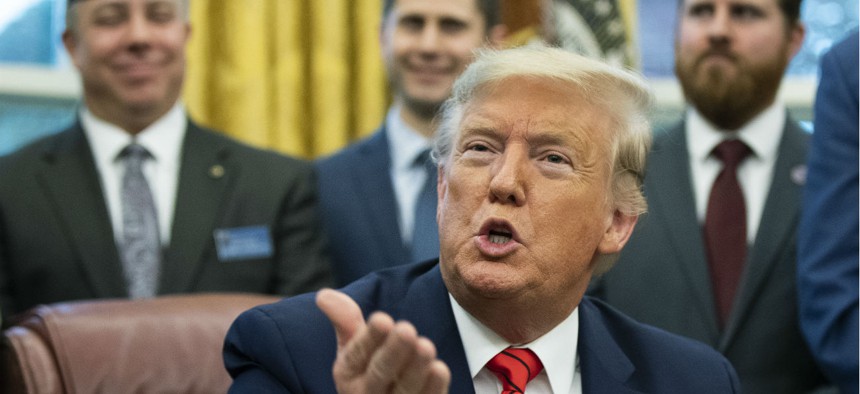11 Major Agency Reforms in Trump's 2021 Budget
Some programs would be eliminated or reorganized, others would grow.
President Trump proposed many significant reforms to federal agency programs and operations in his fiscal 2021 budget, offering a path to slash $4.4 trillion in spending over a 15-year period.
He identified more than 60 programs and agencies for elimination, which would result in $28 billion in savings next fiscal year. The administration would slash another $20 billion by reducing spending on existing initiatives.
Some agencies would fare well under Trump’s blueprint, adding staff and seeing record windfalls. The White House suggested fewer staffing cuts than it has in previous years, though some agencies—such as the State Department and Environmental Protection Agency—would still see dramatic cuts.
The administration continued to push the reorganization plan it released in 2018, which Congress has largely rejected. Some agencies are still seeking authority to shift functions around, however, arguing it would help them focus on their core missions. Other initiatives may not need legislative authority at all.
Here is a look at 11 of the most significant agency reforms included in the budget.
- Adding Staff: As he has in each of his budgets, Trump called for a hiring surge at the Homeland Security Department. Customs and Border Protection’s request for 750 Border Patrol Agents, 600 customs and officers and 300 border processing coordinators fell roughly in line with previous asks, though that could prove difficult as Border Patrol netted just 112 new agents last year. DHS was much more aggressive in its request for Immigration and Customs and Enforcement, asking for more than 4,000 new agents and support staff. The agency requested funding for 2,000 agents in fiscal 2019 and just 1,000 in fiscal 2020, goals Congress has largely blocked it from meeting.
- Subtracting Staff: The Internal Revenue Service proposed slashing its rolls by more than 1,500 employees, despite requesting an overall budget increase of $528 million. The agency said it would fill critical vacancies only and reduce the number of support positions as it allocates funding for pay increases and other personnel costs. It said new funding would go toward boosting customer service and continuing to implement tax reforms Trump signed into law in 2017.
- Moving Staff: Under Trump's budget, the Secret Service, now part of Homeland Security, would be shifted back to the Treasury Department where it was prior to the creation of DHS in 2003. The administration said the move reflects new challenges inherent in the agency's currency protection mission. “The budget proposes legislation to return the U.S. Secret Service to Treasury to create new efficiencies in the investigation of these crimes and prepare the nation to face the threats of tomorrow,” the White House said. In the process, the agency would add 119 new agents.
- A New Agency: The administration proposed moving the tobacco portfolio currently within the Food and Drug Administration to a separate entity within the Health and Human Services Department. The change would enable FDA to focus on its core mission of food and medical safety, the White House said. “A new agency with the singular mission on tobacco and its impact on public health would have greater capacity to respond strategically to the growing complexity of new tobacco products,” the White House said. Additionally, the alcohol and tobacco portions of the Alcohol, Tobacco, Firearms and Explosives Bureau, now part of the Justice Department, would find a new home at Treasury.
- Continuing Cuts: The Defense Department vowed to slash 5% of its spending on all departmentwide offices and agencies, part of an ongoing effort to reduce its “Fourth Estate” costs. Defense, which has sought to reduce staffing across those agencies, said it saved $6 billion from its efforts in fiscal 2019 and would save $5 billion more in fiscal 2021.
- De-federalizing Disaster Preparation: Trump called on state and local entities to fund their own training for disaster preparedness, suggesting the Federal Emergency Management Agency slash $535 million for continuous training grants.
- De-federalizing Electricity: As he did in his government reorganization proposal, the president called on the Energy Department to sell off federal utilities such as the Southwestern Power Administration, Western Area Power Administration and Bonneville Power Administration. The administration previously said offloading all federal transmission entities would save $9.5 billion and enable “a more efficient allocation of economic resources.”
- No New Lands: Trump called for the Interior Department to virtually eliminate all land acquisition projects, saying it could save $132 million to instead focus on improving visitor services and making repairs to existing parks and other sites.
- Criminal Justice: The Justice Department requested more than $400 million to implement the First Step Act, landmark criminal justice reform Trump signed into law in 2018. Justice said the spending would focus on reducing recidivism, such as by enabling the Bureau of Prisons to fund 8,700 new slots at halfway houses and boosting job and life skills training.
- Record Increases: The Veterans Affairs Department would see a 14% funding boost under Trump’s proposal, bringing it to a record $105 billion budget. New funds would go to services such as an 82% increase in opioid prevent and treatment spending and a 32% boost to suicide prevention.
- Eliminations: Among the programs and agencies slated to be zeroed out were 11 Education Department programs the administration deemed wasteful, while it would consolidate 29 Education programs into one block grant to “remove federal bureaucracy” from the process. The White House called for the end of the Public Service Student Loan Forgiveness Program. Interior would end loans and welfare programs designed to benefit Indian Country, deeming them duplicative. The Labor Department would close “low-performing” job corps centers and the Environmental Protection Agency would slash $600 million in spending on 50 programs it called wasteful and outside of its core mission. The Housing and Urban Development Department once again proposed cutting $4.8 billion by eliminating the Community Development Block Grant and the HOME Investment Partnerships Program.




